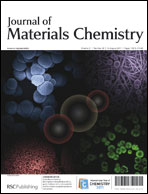We describe here the synthesis and characterization of the octa-, hexadeca- and tetraicosa-brominated derivatives of octaphenylsilsesquioxane, [PhSiO1.5]8 or OPS, which offer high 3-D symmetry. Surprisingly OPS catalyzes its own bromination in refluxing CH2Cl2, in the absence of a traditional Lewis acid catalyst, leading unexpectedly and with high selectivity (≥85%) to the ortho-bromo product, [o-BrPhSiO1.5]8. It appears that the electrophilic character of the cage polarizes the Br2 molecule promoting bromination at the ortho position. Thereafter, with the introduction of a Lewis acid catalyst or simply through prolonged bromination without a catalyst, it is possible to double the number of Br's to produce primarily crystalline [2,5-Br2PhSiO1.5]8 in yields of 80+%. Extended catalytic bromination provides the disordered tetraicosa-brominated compound [Br3PhSiO1.5]8 in low yields. The latter two compounds have bromine densities of 9.5 and 8.4 Br per nm3, respectively, some of the highest densities of Br compounds found in the literature. Crystalline [2,5-Br2PhSiO1.5]8 offers single crystal densities of 2.32 g cm−3 and a calculated refractive index of 1.7 where sapphire is 1.76. The brominated compounds were characterized using NMR, FTIR, TGA and single crystal X-ray diffraction. This set of compounds offers the potential viacatalytic cross-coupling reactions to produce spherical molecules with some of the highest degrees of functionality possible for any first generation star/hyperbranched cores.
![Graphical abstract: [PhSiO1.5]8 promotes self-bromination to produce [o-BrPhSiO1.5]8: further bromination gives crystalline [2,5-Br2PhSiO1.5]8 with a density of 2.32 g cm−3 and a calculated refractive index of 1.7 or the tetraicosa bromo compound [Br3PhSiO1.5]8](/en/Image/Get?imageInfo.ImageType=GA&imageInfo.ImageIdentifier.ManuscriptID=C1JM11536G&imageInfo.ImageIdentifier.Year=2011)
You have access to this article
 Please wait while we load your content...
Something went wrong. Try again?
Please wait while we load your content...
Something went wrong. Try again?
![Graphical abstract: [PhSiO1.5]8 promotes self-bromination to produce [o-BrPhSiO1.5]8: further bromination gives crystalline [2,5-Br2PhSiO1.5]8 with a density of 2.32 g cm−3 and a calculated refractive index of 1.7 or the tetraicosa bromo compound [Br3PhSiO1.5]8](/en/Image/Get?imageInfo.ImageType=GA&imageInfo.ImageIdentifier.ManuscriptID=C1JM11536G&imageInfo.ImageIdentifier.Year=2011)

 Please wait while we load your content...
Please wait while we load your content...